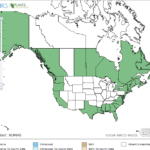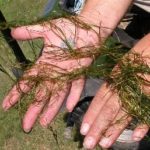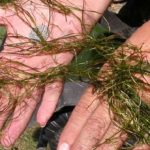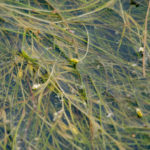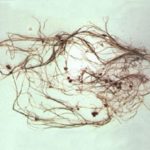Ruppia maritima
USDA, NRCS. 2018. The PLANTS Database (http://plants.usda.gov, 28 March 2018). National Plant Data Team, Greensboro, NC 27401-4901 USA.
Illustration courtesy of University of Florida/IFAS Center for Aquatic and Invasive Plants. Used with permission.
What is Widgeon Grass?
Physical Characteristics
Leaves:
- All submerged
- Thread-like
- Up to 4 inches long & 0.02 inches wide
- Sharp pointed
Flowers:
- Located on short peduncle
- Immobile
Stem:
- Whitish or green in color
- Up to 3 feet long
Where Does it Grow?
Widgeon grass can be found along the Gulf Coast.
Pros and Cons of Widgeon Grass
Widgeon grass is a very important wildlife plant with the stems and leaves being heavily utilized by many duck species. Submerged portions of all aquatic plants provide habitats for many micro and macro invertebrates. These invertebrates in turn are used as food by fish and other wildlife species (e.g. amphibians, reptiles, ducks, etc.). After aquatic plants die, their decomposition by bacteria and fungi provides food (called “detritus”) for many aquatic invertebrates.
